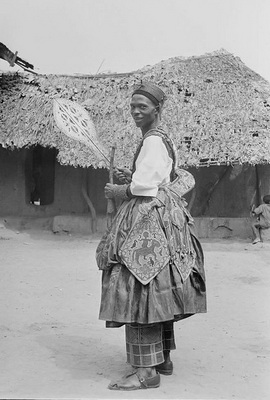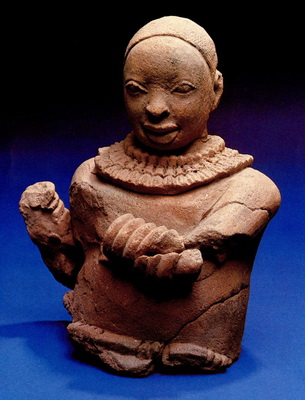

The people of Owo are found in Ondo State of Nigeria. It was the capital of a Yoruba-city-state between 1400 AD and 1600 AD. Owo is a Local Government Area of Ondo State. It has a population of 222, 262 based on 2006 population census. The city is bounded by Ifon, Uso and Benin. The people are predominantly farmers and art workers (sculptors and ivory carvers). Their agrarian land is used to plant cash and food crops such as coco, plantain, yam, rubber, cassava, cocoyam etc. The people are led by a king titled ‘Olowo of Owo’. The people are predominantly farmers that grow food and cash crops. The main language spoken here is the Owo dialect and Yoruba language. |
 |
Owo is a Local Government Area in Ondo State, Nigeria. Between 1400 and 1600 AD, it was the capital of a Yoruba city-state. The local government has a population of 222,262, based on 2006 population census.
The Owos are a subgroup of the Yoruba people in Eastern Yorubaland who trace their origin to Ile ife. The Owo Kingdom is ruled by the Olowo, Oba Folagbade Olateru Olagbegi III, who is the eldest son of the previous oba, Olateru Olagbegi II.
The Owo kingdom is comprised of many other towns and villages apart from Owo town itself. Such settlements include Emure Uli (Emure Ile), Uso, Upele (Ipele), Upenmen (Ipeme), Amuren etc. Traditionally the towns in the Osse local government were all at the beck and call of the Olowo, such as Ifon omimah, Ute, Ujagba (Ijagba), Arimogija, Okeluse, Ogbese, Sobe, Ido-Ani, Ugbonla etc.
Owo is one of the most historic and prolific centres of Yoruba civilizations, producing several works of art in various media, such as brass, and terracotta. Owo is also said to have the largest palace (Aghofen) in Africa which, it sits on 9 and a half acres of land, and was declared a national monument by the federal government. The Olowo Palace had as many as 100 courtyards (Ugha). Each courtyard had a specific function and was dedicated to a particular deity. The largest, said to have been twice the size of an American football field, was used for public assemblies and festivals. Some courtyards were paved with quartz pebbles or broken pottery. Pillars supporting the veranda roofs were carved with statues of the king mounted on a horse or shown with his senior wife. Owo is divided into the Following districts.
In their oral tradition, Owo traces its origins back to the ancient city of Ile-Ife, the cradle of Yoruba culture. Oral tradition also claims that the founders were the sons of the Yoruba deity Odudua, who was the first ruler of Ile-Ife. The early art-historical and archaeological records reinforce these strong affiliations with Ife culture. Owo was able to maintain virtual independence from the neighboring kingdom of Benin, but was on occasion required to give tribute. The transmission of courtly culture flowed in both directions between the Benin and the Owo kingdoms. The skill of Owo's ivory carvers was also appreciated at the court of Benin. During the seventeenth and eighteenth centuries, Benin's rulers increasingly utilized insignia made from ivory, and imported Owo's art objects and recruited its artisans for their own royal workshops. There were other notable artworks that can be evidently supported.
Owo came under British rule in 1893. After Nigeria declared independence in 1960, it was part of the Western Region until 1967 when it became part of the Western State. Owo and its indigenes played significant roles in the politics of the first Republic in Nigeria. In 1976, it became part of the newly created Ondo State.
The Palace of the Olowo of Owo is the largest Palace in Africa.


Owo has the largest palace (Aghofen) in Africa which was declared a national monument by the federal government. The Olowo Palace had as many as 100 courtyards (Ugha). Each courtyard had a specific function and was dedicated to a particular deity. The largest, said to have been twice the size of an American football field, was used for public assemblies and festivals. Some courtyards were paved with quartz pebbles or broken pottery. Pillars supporting the veranda roofs were carved with statues of the king mounted on a horse or shown with his senior wife. The most recent Olowo was Oba Folagbade Olateru Olagbegi III.

The present-day city is an agricultural center involved in the growing and trade of yams, cassava, maize, okra, peppers, cocoa, and cotton. There are, however, other meaningful commercial activities in the town, including but not limited to: timber and sawmilling, Soya bean processing plants and blockmaking industries. The town is dotted with branches of some of the foremost banks like, First Bank Plc, Wema Bank Plc, Skye Bank Plc, Enterprise Bank Ltd. (formerly Omega Bank Plc), etc. The city is now witnessing a dramatic change due to expansion of its road network, particularly dualization of the main road beginning from Emure junction up to Iyere exit. A new ultra-modern market is now open in Owo.
The Owo site was first excavated in 1969–1971 by Ekpo Eyo under the auspices of the Department of Antiquities of the Government of Nigeria. Due to Owo's location between the two famous art centers of Ife and Benin, the site reflects both artistic traditions. Important discoveries include terracotta sculptures dating from the 15th century. The Owo Museum, founded in 1968, houses many of these artifacts.


Owo is an important town in Ondo State and its king is a first class Oba in the country. The town is the headquarters of a local government as well as the seat of several educational institutions. Blessed with a good network of well-paved township roads, Owo is also a place where culture and the arts are joined together in an aesthetic wedlock.
Because the founders of Owo migrated from Ile-Ife, and the town is situated close to Benin, two globally acclaimed arts cities, Owo’s arts started evolving soon after the first set of settlers arrived at what came to be known as Okemade in the town. Professor Ekpo Eyo, then director of the Federal Department of Antiquities, after conducting excavations at Igbo’Laja in Owo in 1969, unearthed several objects that showed Owo’s close links with Ife and Benin. Till date in Owo, the people are celebrated artists who exhibit their skills in the use of wood, ivory, coral, terracotta, bronze and other media.
And like other Yoruba towns, Owo isn’t without its own festivals and traditional practices. In Ile-Ife, no fewer than 2001 deities are worshipped. As people migrated from the acclaimed source of the Yoruba race, they went along with their gods. When the people got to Owo, festivals attached to the gods, like Ogun and the like were celebrated. But as the years went by, circumstances demanded other festivals. Today, Owo has some unique festivals that stand the town out. The Ore and egungun festivals were created after the people got to Owo. There is the Ero festival which takes place in the town every nine years. It is the festival celebrated for old people who are retiring from active community service and are taking up advisory roles in the town.
But what has become very significant in Owo is the Igogo festival, a carnival-like fiesta with a notable history.
Sources: